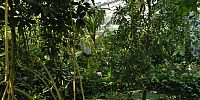© 2007 Seb Perez-Duarte, All Rights Reserved.
In its most general acception, the mangrove is a very particular tropical or sub-tropical forest in inter-tidal zones, where plants seem to grow on water, and the roots are apparent in the air. Plants in a mangrove are a marvel of adaptability, being able to cope with very inhospitable conditions, from low oxygen in the soil, variable salinity, intense sunshine and tidal floods. Mangrove plants have evolved a wide range of mechanisms allowing them to find sustenance where other plants would have failed.
Mangrove plant roots are able to take oxygen through the bark; roots can filter out salt; excess salt in the sebum is excreted in the leaves or in special reservoirs; mangrove plants don't disperse seeds but germinate while still attached to the three, either in the fruit or through it. This seedling is able to survive in harsh conditions, resisting dessication for over a year. The mangrove plants are thus able to sustain there existence even through generations.
Of course mangroves are not native to Germany, where this panorama was taken. But the conditions of the mangrove swamp have been recreated in one of the Palmengarten's greenhouses. The Palmengarten is a botanical garden in Frankfurt-am-Main, opened in 1871, and is the largest of its kind in Germany. Walking through the interconnected greenhouses (with tropical, subtropical and semi-arid components) feels like entering a Biosphere II world, where all plants and the minimal ecosystem around them have been kept, as a spaceship on its way to another planet would have, with the ability to sustain life over decades.
Settings: 1/25s f/8, WB: Sunny, JPG.
Stitched with hugin, enblend, edited with the Gimp and converted into QTVR with Panotools Scripts (erect2qtvr).



 Tap or click the zoom icon in the bottom right corner of the picture to switch between in-page and fullscreen view
Tap or click the zoom icon in the bottom right corner of the picture to switch between in-page and fullscreen view